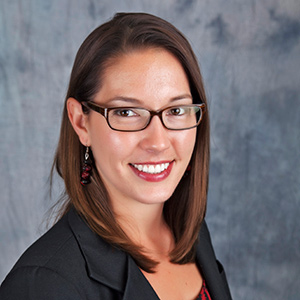
Justine Darling Restorative Practices Coordinator for SDUSD
Justine Darling, M.A., will be teaching restorative practices in San Diego State University’s new online programs for educators and counselors. The programs, the Advanced Certificate in Mental Health Recovery and Trauma-Informed Care, and a Master of Arts in Education (counseling), start in August.
Darling is currently piloting a restorative justice program for San Diego Unified School District as the restorative practices coordinator for the National Conflict Resolution Center (NCRC). She also teaches restorative justice classes as a faculty fellow in the Honors College at SDSU and in the master’s program for peace and justice studies at the University of San Diego (USD).
Before her current role, Darling co-founded a restorative justice program at USD in 2010 and trained more than 250 professionals and graduate students in restorative practices. She has led more than 250 community building circles and 100 restorative conferences worldwide to address harm and hold offenders accountable for their actions.
Darling received a B.A. in psychology and an M.A. in peace and justice studies at the Joan B. Kroc School of Peace Studies at USD and is currently a Ph.D. candidate in education at SDSU.
For more information on SDSU’s new online programs for educators and counselors, visit coe.sdsu.edu/onlinecounsel, email OnlineCounsEd@sdsu.edu, or call (619) 356-1175.
Following is a restorative justice article that Darling authored for the San Bernardino City Unified School District:
Restorative Transformations in SDUSD
By Justine Darling
At the August, 2014 San Diego Unified School Board meeting, I witnessed a student named Khalid share his story of being an English language learner and first generation student in the U.S. As he stood at the podium with a shaking voice, he explained that he was a 10th grader suspended for three days for fighting back after being bullied for months because of his accent. He started to cry as he shared how he was not doing well in school even before the suspension, and the day he was sent home, he even considered ending his life. He said his parents could not help him with school work because they did not speak English and he ended up failing one of his classes after missing the three days of suspension. He pleaded for more restorative outcomes for students and more support for students who get in trouble. His wish was granted when the board declared that the San Diego Unified School District (SDUSD) would work towards becoming a restorative district starting in the fall of 2014. In that same meeting, the board shifted the 15 zero-tolerance offenses down to 5 so that school personnel have more discretion over what cases are recommended for expulsion. The board also hired a part time Restorative Practices Coordinator to support the district in its pilot year of 2014/2015. These were important steps in beginning the long and slow process of becoming more restorative as a district.
As the person hired to be the Restorative Practices Coordinator for SDUSD, I have seen the challenges of students with diverse ethnic identities and the struggles they face. Even though African American and Latino students are a minority of the student population in secondary education, they represent “70 percent of students involved in school-related arrests and referred law enforcement” (Ward, 2014). Similarly, SDUSD has challenges with discipline rates for minority students like most districts across California. In the 2012/2013 SDUSD report for suspensions and expulsions, it was found that white students accounted for 23.2% of students in the district but they only represented 11% of the suspensions and expulsions. In contrast, Hispanic students represented 46.5% of the student population and almost 60% of suspensions and 55% of expulsions. Similarly, African American students represented 10.2% of the student population and 20% of suspensions and 25% of expulsions.
Because students of color are suspended and expelled more than the population they represent, they are at an academic disadvantage. When students are taken out of school for misbehavior they feel ostracized from their school community and their grades suffer due to absence from school (Martineza, 2009). I am passionate about restorative justice because it brings students and impacted community members together to address harm and find ways of making it right while keeping students in school. Students can be held accountable for their actions and learn from mistakes while staying engaged in the school community and not missing valuable class time through restorative practices.
My path to restorative justice started with the frustration I felt while working with homeless and foster youth to pass their GED test at the Covenant House in Newark, New Jersey. Despite the students’ 100% pass rate, it was doing little to save them from the cycles of poverty and violence they faced. I witnessed how the shortcomings in our education and criminal justice systems were fueling a cycle of youth drop outs and criminality. This harsh reality led me to look for a better way that could help young people succeed while holding them accountable for their actions. I discovered restorative justice during my Master’s studies and have spent the last five years implementing restorative justice in education.
Within the restorative pilot in SDUSD this year, one of the projects involves supporting a class of 25 high school juniors to become peer circle facilitators. I trained them for 1 hour a day for 12 days in their law class during the fall semester. We sat in circle every day and learned about what it means to be a circle keeper and explored the different components of circle keeping including setting ground rules, sharing talking pieces and center pieces, developing powerful opening and closing inspirations, and choosing appropriate questions. I have never seen a group of teenagers so engaged and deeply moved as the day we shared opening and closing inspirations for our circles. Eric shared a short quote about splashing in the puddles after it rains and began crying as he told us about the positive influence his grandmother had on him before she passed away a year ago. Shian played an instrumental song and had us all hold hands as she shared a poem about arising with hope in our hearts every day. Every student shared a piece of themselves and what brings them meaning in life. There were tears and there was laughter as we experienced the power of the circle that provided a safe space for each student to authentically share. I could see the pride and empowerment in their eyes as they realized that they would be responsible for creating similar powerful experience for other students as circle facilitators throughout the spring semester.
The student feedback from the circle training was very positive and transformational. One example is of a student named Angel, who shared during the third week of training that his family is not close and they do not talk about or share feelings. The first week of circle training he saw his 8 year old sister crying at home. The typical response in his family was to just ignore such emotional situations. Based on Angel’s restorative circle training, he let his little sister calm down and asked what was wrong instead of ignoring it like usual. They had a long talk where he shared that he had similar thoughts and feelings when he was her age and they could “work” through it together. In the weeks following, she came to her big brother and asked if they could talk multiple times. Angel shared that they have been opening up to each other and the sibling support has made them both feel much better.
The student’s goal is to offer community building circles through spring of 2015 to all freshman classes at their school through advisory periods in the morning. Through circles, they want to make deeper connections between teachers and students so that everyone comes to school feeling excited and happy to be there every day. They are measuring student and teacher feelings of connection and safety on campus before the spring semester starts and after the semester is over to see if the community building circles they offer make an impact. They will be supported by school personnel that are trained in circles including the dean of students, counselors, and their teacher, as well as a cohort of university student volunteers who were trained this past fall through a restorative justice class I teach at the University of San Diego’s School of Peace Studies. One of the main strengths of the student plan is that they have an incredibly supportive teacher who has provided the time and resources they need to fulfill their restorative goals. He believes that restorative practices within the school setting and district will not be successful without student buy in and involvement.
I have found that sitting in circle and learning about restorative philosophy not only positively impacts student and classroom dynamics but it also has a far reaching impact on family and community dynamics. This is only the first year of the SDUSD restorative pilot and many other schools are excited to get involved based on the transformations that have already taken place. There is a growing recognition within SDUSD that restorative circles help reduce suspensions and expulsions by building stronger relationships between students and teachers and creating a culture of respect where infractions are less likely to occur. I have seen through my work with SDUSD that restorative practices also provide more educational and supportive accountability plans for students to learn from their mistakes so that high flyers are transformed into high achievers.
References
Martineza, S. (2009). A System Gone Berserk: How Are Zero-Tolerance Policies Really Affecting Schools?
Preventing School Failure: Alternative Education for Children and Youth, 53(3).
Ward, S. F. (2014).
Racial Imbalance Feeds School-to-Prison Pipeline. ABA Journal, 100, 66.


